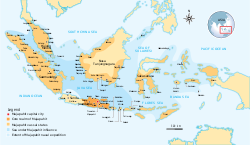
Back Majapahit Afrikaans ماجاباهيت Arabic امبراطورية ماجاباهيت ARZ Imperiu mayapajit AST Маджапахит Bashkir Majapahit BAN Маджапахіт Byelorussian Majapait BEW Маджапахит Bulgarian বিল্বতিক্ত (মজপহিৎ) Bengali/Bangla
| Majapahit Empire | |
|---|---|
 | |
| Kapitolyo | Trowulan, now Mojokerto |
| Relihiyon | |
| Gobyerno | Mandala state ruled by a Maharaja |
| Currency | |
An Majapahit (Plantilya:Lang-jv; Pagsayod sa Habanes: [madʒapaɪt]), midbid man bilang Wilwatikta Pagsayod sa Habanes: [wɪlwatɪkta]), iyo an Javanese Hindu-Buddhist thalassocratic na imperyo sa Habagatan-subangan na Asya na nakabase sa isla kan Java (sa modernong panahon na Indonesya).[4] Nag-eksister iyan poon kaidtong 1293 sagkod kan circa 1527 asin naabot an saiyang rurok kan kamurawayan durante kan panahon ni Hayam Wuruk, na an pagreynar poon kaidtong 1350 sagkod kan 1389 minarkahan kan mga conquests na nakalakop sa bilog na Habagatan-subangan na Asya. An saiyang mga nakamit pigkredito man sa saiyang prime minister, Gajah Mada. Segun sa Nagarakretagama (Desawarñana) na sinurat kaidtong 1365, an Majapahit iyo an imperyo kan 98 na tributaryo, nakaunat poon sa Sumatra pasiring sa New Guinea;[5][6] kompwesto kan present-day Indonesya, Singapur, Malasya, Brunei, habagatan na Tailandya, Timor Leste, habagatan-solnopan na Filipinas (partikular an Sulu Archipelago) minsan ngani an sakop kan Majapahit sphere of influence sa ngunyan subject kan mga debate kan mga historyador.[7][8] An naturalesa kan mga relasyon kan Majapahit asin an mga impluwensya kan saiyang mga basal sa ibong na dagat asin man an saiyang estado bilang sarong imperyo nangangagyat man giraray nin diskusyon.[9]
An Majapahit iyo an saro sa huring mayor na imperyong Hindu-Buddhist kan rehiyon asin konsiderado na saro sa pinakadakula asin pinakapoderosong imperyo sa kasaysayan kan Indonesya asin Habagatan-subangan na Asya. Kun minsan pighihiling iyan bilang precedent para sa modernong mga hangganan kan Indonesya.[10] An saiyang impluwensya nakalakop lampas pa sa modernong teritoryo kan Indonesya asin nagin tema kan mga pag-aadal.[11][12]
- ↑ Ooi, Keat Gin, ed. (2004). Southeast Asia: a historical encyclopedia, from Angkor Wat to East Timor (3 vols). Santa Barbara: ABC-CLIO. ISBN 978-1576077702. OCLC 646857823. Archived from the original on 8 August 2016. Retrieved 5 October 2014. Unknown parameter
|url-status=ignored (help) - ↑ Mahandis Y. Thamrin (September 2012). "10 November, Hari Berdirinya Majapahit" (in Indonesian). National Geographic Indonesia. Archived from the original on 26 May 2015. Retrieved 27 May 2015. Unknown parameter
|url-status=ignored (help) - ↑ Hall, D. G. E. (1965). "Problems of Indonesian Historiography". Pacific Affairs 38 (3/4): 353–359. doi:.
- ↑ "Majapahit empire, historical kingdom, Indonesia". www.britannica.com (in English). Retrieved 2022-01-09.
- ↑ Cribb, Robert (2013). Historical Atlas of Indonesia. Routledge. ISBN 9781136780578.
- ↑ Majapahit Overseas Empire, Digital Atlas of Indonesian History
- ↑ Wood, Michael. The Borderlands of Southeast Asia Chapter 2: Archaeology, National Histories, and National Borders in Southeast Asia. p. 36. https://ndupress.ndu.edu/Portals/68/Documents/Books/borderlands-southeast-asia.pdf. Retrieved on 4 May 2015.
- ↑ "Indonesia, The Majapahit Era". Britannica.
- ↑ Sastrawan, Wayan Jarrah (2020-01-09). "Was Majapahit really an empire?". New Mandala. Retrieved 2020-11-01.
- ↑ Sita W. Dewi (9 April 2013). "Tracing the glory of Majapahit". The Jakarta Post. http://www.thejakartapost.com/news/2013/04/09/tracing-glory-majapahit.html.
- ↑ Prapantja, Rakawi, trans. by Theodore Gauthier Pigeaud, Java in the 14th Century, A Study in Cultural History: The Negara-Kertagama by Rakawi Prapanca of Majapahit, 1365 AD (The Hague, Martinus Nijhoff, 1962), vol. 4, p. 29. 34
- ↑ G.J. Resink, Indonesia's History Between the Myths: Essays in Legal History and Historical Theory (The Hague: W. van Hoeve, 1968), p. 21.

